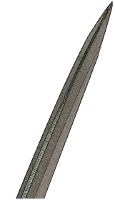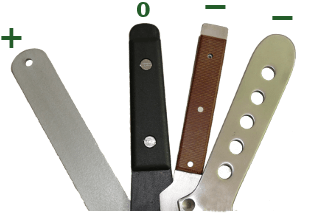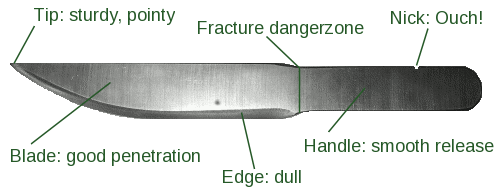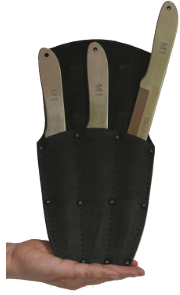
For your regular Thunk!, you need decent throwing knives. Learn which balance, weight, handle shapes, and tip types make your throwing knives stick. Because let's face it, the small fancy throwing knife you bought on a whim simply won't stick in the target wood. Read on to understand what features your perfect throwing knife needs - apart from enough heft and a pointy tip - and how to care for your knives.
Once you know which throwing knives suit you, head over to the knife reviews and collections, our throwing knives shop, or learn how to make your own throwing knife. If knives are not your game, how about throwing cards or axes?

The center of gravity should be in the middle of the throwing knife (lengthwise), plus or minus 1.5cm (compare green dots, and examples). Thus balanced throwing knives will make nice, round circles in the flight. If the balance point is further off the middle, the circles of the handle and the circles of the blade in flight will be of different diameter, leading to a less predictable throw.
If someone hands you throwing knives that are not center balanced, remember the golden rule: Grip the light end! Hence, a blade-heavy knife would only be held at and thrown from the handle. Try out the wrong way: if you grip the heavy end, the center of gravity will be inside or close to your hand, and the knife release will not be smooth.
Weight and dimensions of a good throwing knife need to be in a sensible relation. The ratio of weight per length of a well balanced throwing knife goes from 8 g per cm to 12 g per cm. While most good throwing knives (such as the Hibben or Faka) position themselves within this balance ratio range, you will find outliers with a good reason, such as a hefty Mountain Bowie. Ideally, you first decide which weight is appropriate for you, and then chose the throwing knife with the right dimensions.
Dive into our dedicated page for more considerations about the perfect balance of throwing knives.

A decent throwing knife should not have a sharp blade! You might easily cut yourself when handling it, and bounces from the target become really dangerous. Blade grips are only possible if the edge is blunt. Throwing knives will not stick better with a sharp blade! The major factor to properly stick a knife is a good throw that has the knife reaching the wooden target point first.
A pointy tip is sufficient to enter the wood well. Avoid thick tips, they require more force to enter the wood. If the knife reaches the target point first, and then simply "drops down", that's a clue for a tip that's too fat. For stability and penetration power, the perfect point starts from a sturdy blunt blade, geting small and flat towards the point - see drawing. (No elongated "needle-points" though, they tend to break.) Make sure the point of your throwing knife is double sided, because a thick back that does not flatten at the tip will make the knife hard to stick.
Sharp blades are difficult to restore once you put a dent into the edge - a thing that will definitely happen during throwing practice. One more reason to stick with blunt blades for throwing knives.
First of all, not too light. A throwing knife weight of around 200g is perfect to begin with. Lighter knives ("floaters") are hard to control and often bounce back from the target at random. For longer distances starting at 5m you should turn to a heavier throwing knife with a weight of at least 250g. Once your throwing knife packs 400g or more, you definitely need strong arms and a body trained to handle it.
Try it out: Take the throwing knife handle between your thumb and index finger, the blade points to the ground. Now make a jerk with your arm into some save direction. If the handle wobbles between your fingers, or the throwing knife even falls down, it is too heavy (perhaps some finger training can help).
Generally, heavy throwing knives are more stable in their flight. This is because more throwing knife weight means more mass means more inertia means you can make small mistakes without influencing the flight. But by far not everybody has the strength needed to throw a heavy knife accurately. I recommend starting with a lighter throwing knife model to develop the sensitiveness needed, a subsequent switch to throwing knife models with more weight is real easy then.
I do prefer throwing knives without a specific handle, that is everything out of one piece of steel. They glide from your hand smoothly upon release, and that's what you're looking for.
Plastic, wood or even leather, commonly fixed with the help of rivets, will eventually come off and has to be ![]() replaced. But some people find that a wooden handle really is comfortable to grip, or that handleless knives are too tiny for their paws.
replaced. But some people find that a wooden handle really is comfortable to grip, or that handleless knives are too tiny for their paws.

If you absolutely need to throw something with a knob or ring at the end, use a ![]() palm grip.
palm grip.
Have a look at the handle examples in the picture: the first (leftmost) is a great straight one-piece handle that allows for a good release. The black scales can be removed via screws, so that's ok. The rivets on the brown handle scales already started to come off. The holes in the rightmost handle catch in your palm (and catch dirt) and generally introduce fracture weaknesses into the knife.
If a throwing knife slips out of your hand too early (despite your fingers being strong enough), you could improve your grip by putting some tape around the handle, crepe tape or insulating band for example. To insure a smooth release, do not use material that is too rough, and wrap the last layer from the handle end to the middle of the throwing knife.
Wrapping the handle in paracord is nothing any knife thrower I know does. The coarse wrapping would lead to a wobbly release, and you'll surely cut the cord as soon as you throw your knives close to each other into the target.


The sheath delivered with your throwing knife will be sufficient in most cases. It should ensure that the knife will not fall out (sewn tight, snap-fastener or loop). A leg string comes in handy as it prevents your tool from banging against your thigh when walking. If you ![]() attach a few string loops to a sheath, you can wear it nearly everywhere.
attach a few string loops to a sheath, you can wear it nearly everywhere.
Of course you can make or buy special sheaths, for example to wear them on the back like a cowboy and draw from behind your neck. ![]() Instructions for such a harness can be found at thrower. The tubular webbing required can be found in sewing stores, and in outdoor stores in the climbing section. It feels cool to draw and throw your knife this way, but putting the knife back in place is a little bit tricky.
Instructions for such a harness can be found at thrower. The tubular webbing required can be found in sewing stores, and in outdoor stores in the climbing section. It feels cool to draw and throw your knife this way, but putting the knife back in place is a little bit tricky.

Keep it clean! Sure, but how to clean your throwing knives? Luckily, it is sufficient to scrub the throwing knife clean with a wet washcloth (or old rag) to get rid of dirt stains. Then rinse it with water, and dry it. It hast to be absolutely dry! Then store it somewhere safe and dry. If you do this cleaning and drying routine after every training day, even non stainless knives will not rust. This is the secret of how to properly clean and store your throwing knives.
On the contrary, guaranteed ways for rendering your throwing knives rust-speckled are storing them while still wet or covered in dirt, or leaving them outside overnight. Superficial rust can be removed using metal polish paste - get yourself a paste suitable for bright metals, such as "ako polish".
If you really want to pamper your knife, coat it with ![]() Ballistol, a versatile protective oil. (Available in drugstores and home improvement stores.) Rub it off before throwing, or the knives will be slippery. You might also try
Ballistol, a versatile protective oil. (Available in drugstores and home improvement stores.) Rub it off before throwing, or the knives will be slippery. You might also try ![]() high tec fluids.
high tec fluids.
Collisions with other throwing knives or rocks on the ground will lead to nicks. Be sure to fix those before you throw again, or you risk cutting your skin while releasing the knife. Luckily, it is easy to repair notches - even at the tip, since you do not need a real sharp point. Start by securing your throwing knife in a vise. Then employ a metal file to smooth the nick, or fix a ![]() flapwheel to your power drill or angle grinder.
flapwheel to your power drill or angle grinder.
If the knife is bent from throwing, simply place it across two bricks and stand on it till it is straight again.
Over at thrower there is an article on ![]() how to keep your knife in perfect throwing condition.
how to keep your knife in perfect throwing condition.
The advantage of having multiple throwing knives is that you can throw them at the target without having to stop and collect your sole knife. This makes training more efficient, as it's much easier to get a feel for the throwing motion when you can repeat it instantly, without having to walk in between.
Training with different models in the same training session is not recommended. The differences in the knives mean you can never be sure if your imperfect throw is due to your throwing motion or the knife characteristics.
For most sports knife throwers, the best compromise between the number of times you can throw without walking, the money you spend, and the weight you have to hold in your hand comes down to throwing three knives in training. In competitions, you are expected to bring three throwing knives, to ensure that the events can proceed swiftly.
To retain your knives, do get into a habit of instantly collecting any knife that falls to the ground if you are in an area with high grass or leaves on the soil. The same goes for knives that fall down in some distance from the target. Otherwise, if you try to find it later after having thrown the other knives, you think you'll remember where it fell down - but in fact wont. Sometimes it's as if the knives had little feet on them to run to a different place where you will never think to look. Take this hint from somebody who has spent hours looking for those scuttle knives.
I suggest you look around and find a throwing knife that suits you. If, after a few training days, you still like it, go ahead and buy 2-3 more of it.
We learned why throwing knives must not be too light, how sharp edges will cut your palm, and how fancy nooks will catch skin on release. Putting it all together to define the perfect throwing knife:
The best throwing knives for beginners

For beginners, my personal recommendations for the best throwing knives is the ![]() Faka.
Faka.
Now you got all the knowledge to choice the best throwing knives for you. Read our reviews of throwing knives to see what kind of knives are available on the market. Then have a look around if there is a local store where you can actually hold the knives in your hand and get a feel for them.
If the best throwing knife for you is not available in a store near you, you can find proven throwing knives in ![]() our own throwing knife shop - and more specialised shops in our linklist.
our own throwing knife shop - and more specialised shops in our linklist.

Buy your perfect throwing knife ![]() in our online shop.
in our online shop.